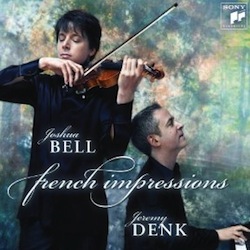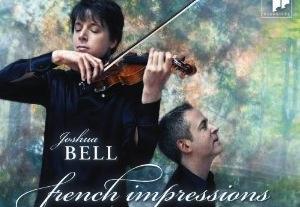
It is generally unwise to draw conclusions from the cover art that record labels attach to recordings. Alfred Brendel reputedly had a contractual agreement whereby his image had to be on the front of everything he recorded for Phillips. The reason that everything clarinetist Thea King recorded for Hyperion had to have cattle somewhere in the cover art hasn’t, so far as I know, ever been explained. And you do get the occasional pathetic blunder, like the recording of Richard Strauss’ devastating, and devastated, Metamorphosen, a half-hour-long dirge for Europe in the aftermath of World War II, blithely illustrated with a butterfly. (That was only in this country, naturally; in Europe the cover image was of the ruins of Dresden.)
Yet the iconography of Joshua Bell and Jeremy Denk’s new CD, French Impressions, is, for once, apt. You have Bell, looking 18 years old, tops (he is 44), eyes closed, seemingly in reverie; you have Denk, looking upward; and behind them both, a Monet-hued backdrop. I don’t think it’s an actual Monet, but the colors (golden sunlight dimly seen through verdant trees; suggestions lower down of dappled sunlight on blue water) and the shapes (are those the shades of the bridge of the Water-Lily paintings and of Rouen Cathedral?) make it pretty clear where we are. The title, French Impressions, is in a joined script with letters that are elaborately curvy above and below the main text level.
Listen To The Music
Maurice Ravel Sonata for Violin and Piano. I AllegrettoPurchase Recording

It’s all very beautiful, as is the CD it accompanies. All the same, it does betoken a certain sort of approach.
Bell’s manner in all three works here is as it’s long been in nearly everything: great strength when necessary, poetic tenderness or elfin scherzando everywhere else. The danger, it seems to me, is that he really does like the poetic parts more than he does the strenuous ones, and in consequence his performances start to seem a tad disorienting.
The opening of the first movement of the Ravel Sonata, for example, isn’t the wispy thing he makes of it; compositionally, it’s hard as nails, softened only by the actual, gentle material. The second-movement “Blues” he does his very best with (and “his very best” is, indeed, very good), but all the same I’ve heard a number of violinists, including some without the luxury of living within a plane flight of the birthplace of the Blues, out-Blues him. The finale is the sort of thing Bell could do in his sleep, though fortunately does not. It’s inflected with considerable subtlety.
It’s hard to talk about recordings of the Franck Sonata at all, because it has to be on the short list of most-recorded violin/piano sonatas. A check of ArkivMusic.com showed 157 recordings in print, including Joshua Bell’s previous one, from 20 years ago. (A useless statistic, except for giving an order-of-magnitude view: A lot of those are reissues of recordings also on the list, and many of the others are recordings on cello, flute, and even [ill-advisedly] viola. Still, nothing else is close, except the Beethoven “Kreutzer” Sonata, at 140.)
What the work of a Belgian, written as a wedding present for a countryman, is doing taking up one-third of a disc titled French Impressions, I’ll let the folks at Sony try to figure out. Historically, Belgians have not been keen on being mistaken for French. (Lately, they’re not particularly keen even on being mistaken for Belgians, but that’s a tale for another day.)
The Bell/Denk recording is wonderful — no one wanting to get to know the work (or the two others) could possibly be disappointed. Here, though, as in the Ravel, I found myself wanting a little less wispy poetry and a little more sinew. I am spoiled forever by Kaja Danczowska and Krystian Zimerman.
I need to say, though, that while Danczowska/Zimerman has been my gold standard for the Franck ever since I heard it, Jeremy Denk is in Zimerman’s league in that fearsome piano part, and indeed in the other two nasty piano parts on the disc. Wherever things seem to be getting a tad mistlike in the violin department, here comes Denk with stern rhythm and clean articulation to even the score and set the direction.
As for the Saint-Saëns First Sonata, I’m spoiled again — this time by Jascha Heifetz and Brooks Smith, more than half a century ago. I can admire, violinistically, the way Bell floats that chorale tune the first time it appears, as though it were wafted in from fairyland; all the same, I’d far rather hear it the Heifetz way, as something solid.
Indeed, it all comes down to how much solidity you like. I can admire the Bell/Denk Franck Sonata; I can admire the one that Hilary Hahn and Valentina Lisitsa played at Berkeley four years ago. For me, the violin part is somewhere between “borne in on the wind” and “carved out of marble,” and I’m not entirely happy with either extreme. But, then, I’ve no need to be.

